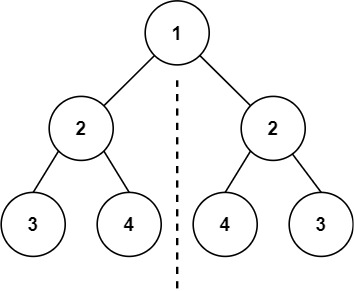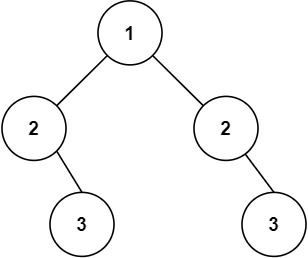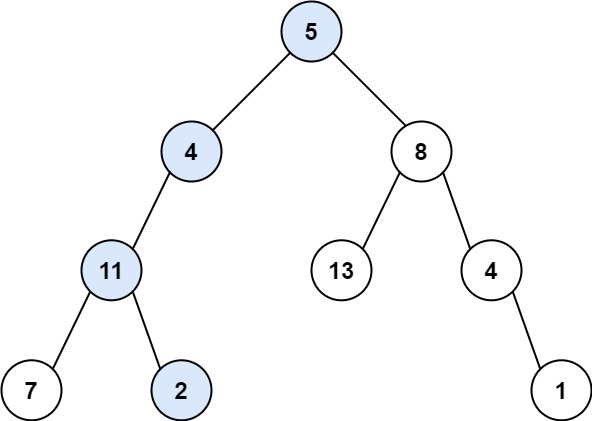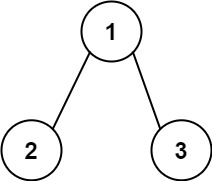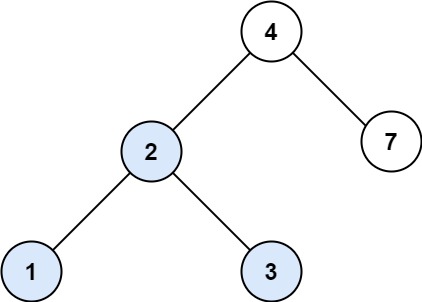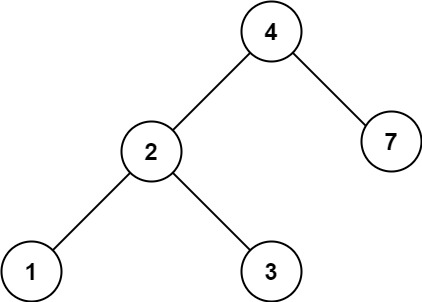深度优先搜索
深度优先搜索算法(英语:Depth-First-Search,DFS)是一种用于遍历或搜索树或图的算法。其过程简要来说是对每一个可能的分支路径深入到不能再深入为止,而且每个结点只能访问一次.
因发明「深度优先搜索算法」,约翰 · 霍普克洛夫特与罗伯特 · 塔扬在1986年共同获得计算机领域的最高奖:图灵奖。
例题
104 二叉树的最大深度
给定一个二叉树,找出其最大深度。
二叉树的深度为根节点到最远叶子节点的最长路径上的节点数。
说明: 叶子节点是指没有子节点的节点。
示例:
给定二叉树 [3,9,20,null,null,15,7],
3
/ \
9 20
/ \
15 7 返回它的最大深度 3 。
/**
* Definition for a binary tree node.
* type TreeNode struct {
* Val int
* Left *TreeNode
* Right *TreeNode
* }
*/
func maxDepth(root *TreeNode) int {
if root != nil {
return max(maxDepth(root.Left), maxDepth(root.Right)) + 1
}
return 0
}
func max(a int, b int) int {
if a > b {
return a
}
return b
}
💣 101 对称二叉树
给你一个二叉树的根节点 root , 检查它是否轴对称。
示例 1:
输入:root = [1,2,2,3,4,4,3] 输出:true
示例 2:
输入:root = [1,2,2,null,3,null,3] 输出:false
提示:
- 树中节点数目在范围
[1, 1000]内 -100 <= Node.val <= 100
进阶:你可以运用递归和迭代两种方法解决这个问题吗?
/**
* Definition for a binary tree node.
* type TreeNode struct {
* Val int
* Left *TreeNode
* Right *TreeNode
* }
*/
func isSymmetric(root *TreeNode) bool {
return check(root, root)
}
func check(p, q *TreeNode) bool {
if p == nil && q == nil {
return true
}
if p == nil || q == nil {
return false
}
return p.Val == q.Val && check(p.Left, q.Right) && check(p.Right, q.Left)
}
226 反转二叉树
给你一棵二叉树的根节点 root ,翻转这棵二叉树,并返回其根节点。
示例 1:
输入:root = [4,2,7,1,3,6,9] 输出:[4,7,2,9,6,3,1]
示例 2:
输入:root = [2,1,3] 输出:[2,3,1]
示例 3:
输入:root = [] 输出:[]
提示:
- 树中节点数目范围在
[0, 100]内 -100 <= Node.val <= 100
/**
* Definition for a binary tree node.
* type TreeNode struct {
* Val int
* Left *TreeNode
* Right *TreeNode
* }
*/
func invertTree(root *TreeNode) *TreeNode {
if root != nil {
root.Left, root.Right = root.Right, root.Left
root.Left = invertTree(root.Left)
root.Right = invertTree(root.Right)
}
return root
}
112 路径总和
给你二叉树的根节点 root 和一个表示目标和的整数 targetSum 。判断该树中是否存在 根节点到叶子节点 的路径,这条路径上所有节点值相加等于目标和 targetSum 。如果存在,返回 true ;否则,返回 false 。
叶子节点 是指没有子节点的节点。
示例 1:
输入:root = [5,4,8,11,null,13,4,7,2,null,null,null,1], targetSum = 22 输出:true 解释:等于目标和的根节点到叶节点路径如上图所示。
示例 2:
输入:root = [1,2,3], targetSum = 5 输出:false 解释:树中存在两条根节点到叶子节点的路径: (1 --> 2): 和为 3 (1 --> 3): 和为 4 不存在 sum = 5 的根节点到叶子节点的路径。
示例 3:
输入:root = [], targetSum = 0 输出:false 解释:由于树是空的,所以不存在根节点到叶子节点的路径。
提示:
- 树中节点的数目在范围
[0, 5000]内 -1000 <= Node.val <= 1000-1000 <= targetSum <= 1000
/**
* Definition for a binary tree node.
* type TreeNode struct {
* Val int
* Left *TreeNode
* Right *TreeNode
* }
*/
func hasPathSum(root *TreeNode, targetSum int) bool {
if root != nil {
if root.Left != nil || root.Right != nil {
if hasPathSum(root.Left, targetSum - root.Val) || hasPathSum(root.Right, targetSum - root.Val) {
return true
}
} else {
if targetSum == root.Val {
return true
}
}
}
return false
}
617 合并二叉树
给你两棵二叉树: root1 和 root2 。
想象一下,当你将其中一棵覆盖到另一棵之上时,两棵树上的一些节点将会重叠(而另一些不会)。你需要将这两棵树合并成一棵新二叉树。合并的规则是:如果两个节点重叠,那么将这两个节点的值相加作为合并后节点的新值;否则,不为 null 的节点将直接作为新二叉树的节点。
返回合并后的二叉树。
注意: 合并过程必须从两个树的根节点开始。
示例 1:
输入:root1 = [1,3,2,5], root2 = [2,1,3,null,4,null,7] 输出:[3,4,5,5,4,null,7]
示例 2:
输入:root1 = [1], root2 = [1,2] 输出:[2,2]
提示:
- 两棵树中的节点数目在范围
[0, 2000]内 -104 <= Node.val <= 104
/**
* Definition for a binary tree node.
* type TreeNode struct {
* Val int
* Left *TreeNode
* Right *TreeNode
* }
*/
func mergeTrees(root1 *TreeNode, root2 *TreeNode) *TreeNode {
if root1 != nil && root2 != nil {
root1.Val += root2.Val
root1.Left = mergeTrees(root1.Left, root2.Left)
root1.Right = mergeTrees(root1.Right, root2.Right)
} else if root2 != nil {
return root2
}
return root1
}
700 二叉搜索树中的搜索
给定二叉搜索树(BST)的根节点 root 和一个整数值 val。
你需要在 BST 中找到节点值等于 val 的节点。 返回以该节点为根的子树。 如果节点不存在,则返回 null 。
示例 1:
输入:root = [4,2,7,1,3], val = 2 输出:[2,1,3]
示例 2:
输入:root = [4,2,7,1,3], val = 5 输出:[]
提示:
- 数中节点数在
[1, 5000]范围内 1 <= Node.val <= 107root是二叉搜索树1 <= val <= 107
/**
* Definition for a binary tree node.
* type TreeNode struct {
* Val int
* Left *TreeNode
* Right *TreeNode
* }
*/
func searchBST(root *TreeNode, val int) *TreeNode {
if root != nil {
if val == root.Val {
return root
} else if val < root.Val {
return searchBST(root.Left, val)
} else {
return searchBST(root.Right, val)
}
}
return nil
}
